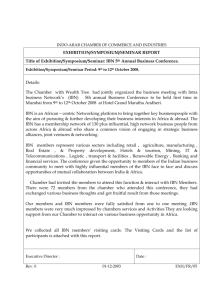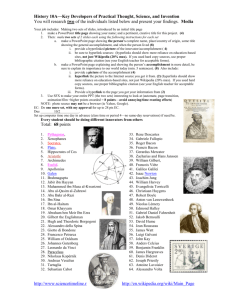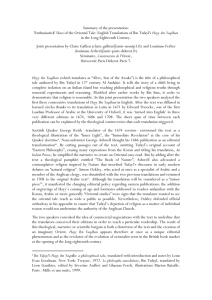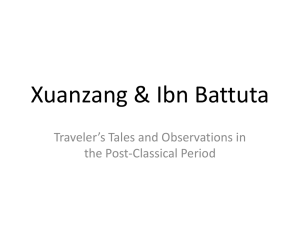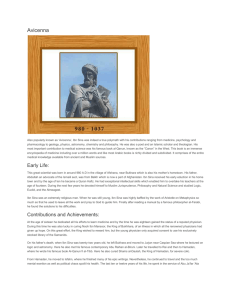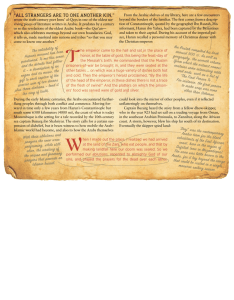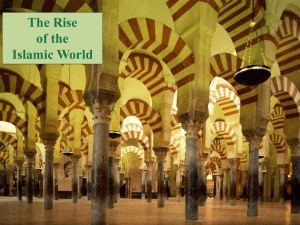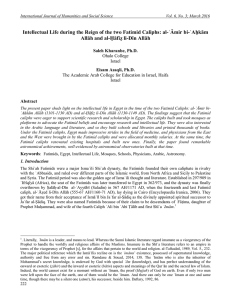Ibn Tufayl's Hayy Bin Yaqzan
advertisement
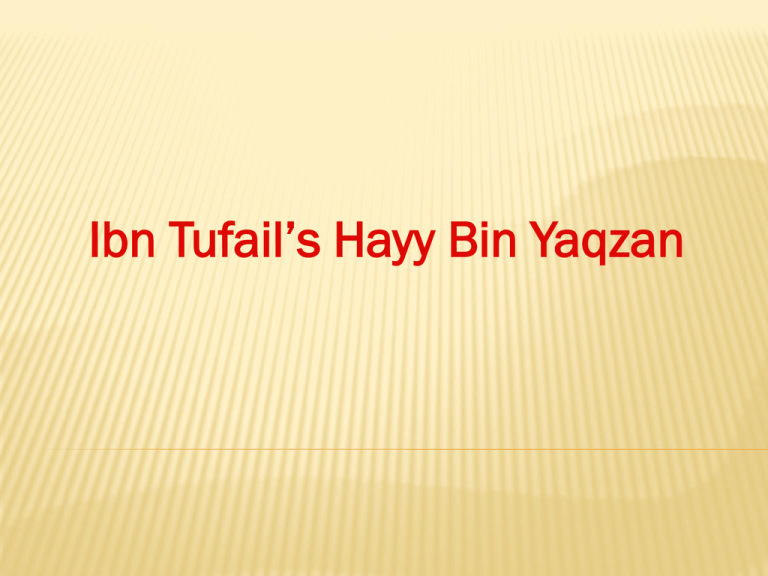
Ibn Tufail’s Hayy Bin Yaqzan IBN TUFAIL Full name: Abu Bakr Muhammad bin Abdul-Malik bin Muhammad bin Tufail al-Qaisi al-Andalusi Title: Ibn Tufayl Abubacer Bin Tofail Abu Jaafar Bin Tophail He was born in 1105 in Wadi Ash Guadix (near Granada), Andalusia and died in1185 Marrakech (aged 79–80). IBN TUFAIL Era: Islamic Golden Age Region: Al-Andalus Jurisprudence: Sunni Islam Main interests: Early Islamic philosophy, Literature, Islamic medicine. IBN TUFAIL - He was an Andalusian Muslim polymath: a writer, novelist, Islamic philosopher, Islamic theologian, physician, vizier, and court official. - Wrote the first philosophical novel, which was also the first novel to depict a child in a desert island. Hayy bin Yaqdhan (Philosophus Autodidactus) LIFE - He was educated by Ibn Bajjah (Avempace). - He served as a secretary and physician for Abu Yaqub Yusuf, the Almohad king, to whom he recommended Ibn Rushd (Averroës) as his own future successor in 1169. Ibn Rushd who wrote the Aristotelian commentaries. - The astronomer Nur Ed-Din Al-Bitruji was also a successor of Ibn Tufayl. - Ibn Tufail was the author of Ḥayy bin Yaqẓān Son of the Awake), also known as Philosophus Autodidactus in the West. Alive, - A philosophical and allegorical novel inspired by Avicennism and Sufism, and which tells the story of an autodidactic feral child, raised by a gazelle and living alone on a desert island, who, without contact with other human beings, discovers ultimate truth through a systematic process of reasoned inquiry. Hayy ultimately comes into contact with civilization and religion when he meets a castaway named Absal. PHILOSOPHERS' RESPONSES Ibn Tufail's Philosophus Autodidactus was written as a response to al-Ghazali's The Incoherence of the Philosophers. In the 13th century, Ibn al-Nafis later wrote the AlRisalah al-Kamiliyyah fil Siera al-Nabawiyyah (known as Theologus Autodidactus in the West) as a response to Ibn Tufail's Philosophus Autodidactus NEED TO KNOW: Hayy Bin Yaqdhan had a significant influence on both Arabic literature and European literature, and it went on to become an influential best-seller throughout Western Europe in the 17th and 18th centuries. The work also had a "profound influence" on both classical Islamic philosophy and modern Western philosophy. It became "one of the most important books that heralded the Scientific Revolution" and European Enlightenment. The thoughts expressed in the novel can be found "in different variations and to different degrees in the books of Thomas Hobbes, John Locke, Isaac Newton, and Immanuel Kant." TRANSLATIONS A Latin translation of the work, entitled Philosophus Autodidactus, first appeared in 1671, prepared by Edward Pococke the Younger. The third English translation (by Simon Ockley) was published in 1708. These translations later may have inspired Daniel Defoe to write Robinson Crusoe. The story of Hayy Ibn Yaqzan takes place on an island uninhabited by human beings. Philosophers were of the opinion that he was born spontaneously when the mixture of elements reached an equilibrium state, making it possible for this mixture to receive a human soul from the divine world. Traditionalists believed that he was the son of a woman who chose to keep her marriage to her relative, Yaqzan, secret from her brother who ruled a neighboring island and did not find any man qualified to marry his sister. After feeding Hayy well, she put him in a box and threw it into the waters, which took him to the uninhabited island. A deer who had just lost her son and was still experiencing the feelings of motherhood heard Hayy's cries. She suckled him, protected him from harmful things and took care of him until she died when he was seven years of age. The deer's death transformed Hayy's life from one of dependency to one of exploration and discovery. In an effort to find out the reason for the deer's death, he dissected her with sharp stones and dry reeds. Noticing that every bodily organ has a proper function and that the left cavity of her heart was empty so that, the source of life must have been in the cavity. Then, he continued to investigate other parts of nature: animal organs, their arrangement, number, size and position, as well as the qualities that animals, plants and inanimate things have in common. Through continued reasoning he grasped the concepts of matter and form, cause and effect, unity and multiplicity, as well as other general concepts concerning the earth and the heavens. Asking himself whether the world is eternal or produced in time. Then, he was led to the conclusion that there exists a Necessary Being who is the Creator of all other beings. In the opposite island, there lived two men, namely Salaman and Absal. They both are very faithful to the religion, by practicing their religious rituals and reading religious texts. Absal liked to isolate himself from the world, whereas Salaman interested to involve in community in order to practice the religion. Because of their difference in thought, Absal decided to go to the opposite island and spent his time alone in worshipping the Absolute Truth. Returning to Hayy, At the age of 50, when he had not communicated with anyone except himself, he met Absal. Absal realized that Hayy did not have an idea of any language so, he tried to teach him to speak and communicate in order to make him aware of knowledge and religion. Also, Absal introduced Hayy to his culture and people. Asal informs Hayy about Quranic conceptions of God, His Angels, prophets, etc. Hayy accepted Asal’s explanations as truths. Then he followed Asal to his island in the hope of reforming the people there. Hayy endeavors hard to enlighten the masses through pure concepts . At the end, he finds these concepts are proved to be too difficult for the masses to understand. Both men returned back to their isolated world and continued searching their ecstasies until they met their ends. ALLUSION TO THE STORY OF MOSES There is an island governed by a king who has a beautiful sister. Although the sister is old enough to get married, the king would not allow her because he could not find someone fitting. But the sister loves one of her relatives named Yaqzan and marries him secretly in accordance with the customs of the community. They name their child Hayy. In order to keep their marriage secret and to prevent their child from getting killed, they find the following solution: the mother puts him in an ark, and brings it to the coast. ALLUSION TO THE STORY OF MOSES(CONT) This narration resembles in many ways the story of the birth and growing up of Moses as occurs in the Qur’an. As is known, when Moses was born, the Pharaoh has a dream in which he sees a male child born in that years oust him. Then he decides to have all the male children of the Israelites who are born that year killed. So Moses mother, in order to save her newborn, puts him in an ark and casts him at night into the dark waters of the Nile. TO SUM UP Without the help of tradition and revelation, man can attain knowledge of the natural world and reality and, through this, to knowledge of God. Even if God has not revealed Himself through His prophets, He would have been discovered by scientists and philosophers through their studies of nature, the human self and the universe. 22 THANK YOU ALL
